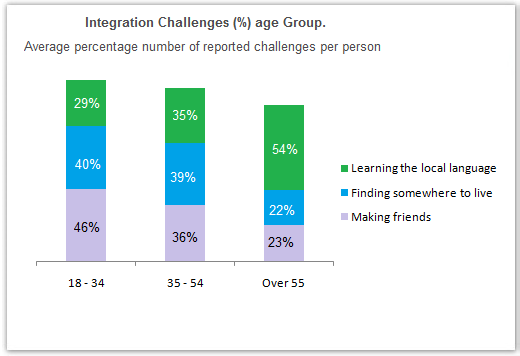» You should spend about 20 minutes on this task.
The chart below shows information about the challenges people face when they go to live in other countries. Summarise the information by selecting and reporting the main features, and make comparisons where relevant.
» Write at least 150 words.

Sample Answer 1
The supplied graph represents the challenges people face when they start living in a different country and compares this data to different age groups. As is presented in the graph, younger people struggle to make new friends while the aged people face difficulty to learn the local language in a new country.
As the graph shows, people from 18-34 years old find it most difficult to make new friends when they start living in a new country. The second most challenging issue they face is the issue of finding a living place. Learning the local language is another problem they face but this is least among the people of this age group. Secondly, among the 35-54 age group, people who go to live in a different country find it most difficult to find places to live. About 36% of people find it difficult to find places to live in while about 35-36% of people find it difficult to learn the local language and to make friends there. Finally, the aged people who are over 55 years old, find it most difficult to learn the language than any other age group. Approximately 54% of aged people face this challenge when they start living in a new country. Among this age group, 22% of people face the living place issue while 23% find it hard to make new friends.
In summary, aged people can make friends more easily than the young age group when they start living in a new country while young population finds it easier to learn the loan language than the aged people in a new country.
Sample Answer 2
The presented chart gives information on the challenges the different age groups of people face when immigrating to another country.
As is presented, the three most common challenges all age groups face are making friends, finding a place to live and learning the local dialect. The biggest difficulty the age group of people aged over 55 faces is learning the local language as compared to the other age groups, who don’t find it as difficult. It is surprising to find that both age groups of 18-34 and 35-54 have challenges in finding a place to settle. It is easier for the age group of over 55 to find a place to settle as they do not have to take many factors into consideration when deciding where to settle, for example, finding a place close to work, what kind of neighbourhood is good for bringing up a family, what public facilities are available in the area, access to the internet etc. But they don’t have a hard time making friends as it is probably easier for them to do when still young.
To summarise, according to this chart, it is easier to go and live in another country while you are still young rather than when you are over the age of 55 as it is more difficult for you to adapt to the new culture and customs in a new country.
Sample Answer 3
The bar chart presents data about the difficult issues people encounter when settling abroad. The given data classifies those challenges into three main categories based on people’s age. Overall, it seems that young people in a foreign country can learn the local language easily whereas older people face fewer challenges to find a place to live in and they can make friends faster.
The first challenge that people face in abroad is ‘making friends. 46% of people whose ages range from 18 to 34 find it as the most challenging task. In contrast, only half of that proportion in the oldest age group considers it difficult. On the other hand, not many young people struggle to learn a new language (only 29%), while more than 50% of people over 55 think that is a real problem (54%). Facing the problem to find a place to live in, about 40% of the younger groups get stuck with it, while it is the least challenging issue for the older people who try to settle in a foreign country.
